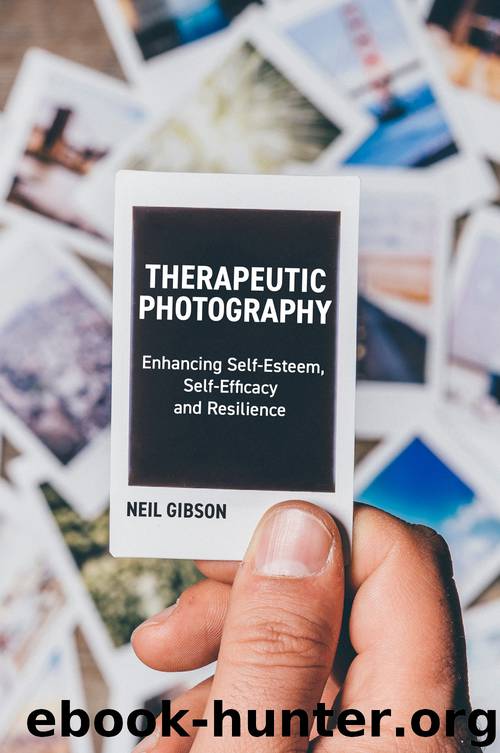Therapeutic Photography by Neil Gibson;

Author:Neil Gibson;
Language: eng
Format: epub
ISBN: 9781784504212
Publisher: Jessica Kingsley Publishers
Published: 2018-07-31T16:00:00+00:00
Change
When we encounter loss, change will inevitably follow. Marris (1986) recognised the inseparability of loss and change and went on to explain that the intensity of the experience is often dictated by the nature of the loss. He outlined three categories which defined change:
1. Substitution – this is often viewed as a positive change, where the old is replaced by the new and life continues as was, or is even an improved version of what was.
2. Evolution – here, change is a natural product of the life course, where change may take place over a long period of time and force a gradual reassessment of attachments within relationships.
3. Deep loss – with this aspect of change, a person has to deal with the loss of love.
Whatever the nature of loss, Marris (1986) identified that humans can often struggle with change because we like equilibrium, familiarity and predictability – change threatens this and forces us into unfamiliar territory. This is akin to Bowlby’s (2008) writings on the importance of the secure base and safe haven where secure attachments can be fostered because there is a sense of routine in a world that can seem chaotic and scary. Marris believed that humans have an innate need for safety and security (much as Maslow (1943) identified in his hierarchy of needs) and one way humans achieve this is by looking for predictability and order. If this goes, then we feel endangered and we try to cling to what we know. Anything that disrupts this order can trigger feelings of futility and bewilderment. Marris (in Parkes et al., 2006) believed that this is compounded when existing attachments are threatened and affected. Any sudden change in relationship status adds to disruption and can have a negative impact on self-esteem and self-identity.
Change in our environments and society also causes disequilibrium and can increase anxiety. Acts of terrorism can leave civilised societies wondering at the barbarity and capabilities of fellow human beings, pushing values and ethics into new, unfamiliar territories. The norms of everyday life are no longer as secure as they once were. Our comprehension of events can also unseat us and force us into dealing with a change in our beliefs, such as trying to fathom why babies and young children can become terminally ill when our expectation of disease is that it targets the elderly and infirm.
The speed at which events unfold can force us into sudden change. If change is both sudden and unexpected it can bring on an immediate juxtaposition within our world. Fortunately, Marris also highlighted the importance of protective factors to assist in coping strategies when change is unleashed. He believed that supportive relationships with open communication and feelings of mutuality are a major protective factor. In analysing these support structures, he returned to the importance of trust, an element Erikson (1963) focused on in his first of eight stages, and wrote that without this, attachments become threatened and important future support structures to assist in guiding through change may
Download
This site does not store any files on its server. We only index and link to content provided by other sites. Please contact the content providers to delete copyright contents if any and email us, we'll remove relevant links or contents immediately.
Systems of Psychotherapy by James O. Prochaska and John C. Norcross(667)
The Expanded Dialectical Behavior Therapy Skills Training Manual by Lane Pederson(604)
The Mentoring Manual by Julie Starr(569)
Emotionally Focused Couple Therapy For Dummies by Brent Bradley(534)
Values in Therapy by Jenna LeJeune(525)
Transformation through Intimacy, Revised Edition by Robert Augustus Masters Ph.D(515)
The Polyvagal Theory in Therapy by Deb Dana(491)
After the Affair, Updated Second Edition by Janis A. Spring(490)
The Gaslighting Recovery Workbook: Healing From Emotional Abuse by Amy Marlow-MaCoy LPC(487)
The Grieving Child by Helen Fitzgerald(459)
Sadomasochism by Kleinplatz Peggy J. Moser Charles(444)
Why Isn't This Marriage Enough by sharon pope(429)
Research Methods for Counseling by robert j. wright(414)
29:16:04:59 by Joshua Johnson(413)
The Mediator's Toolkit by Gerry O'Sullivan(394)
The STOP Domestic Violence Program by David B. Wexler(391)
Safe Haven Marriage by Archibald Hart Sharon Morris(386)
THE HUSBANDS AND WIVES CLUB by LAURIE ABRAHAM(371)
Marriage and Lasting Relationships with Asperger's Syndrome by Eva A. Mendes(370)
